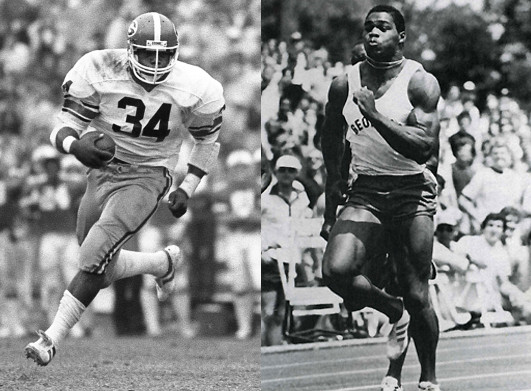
Here is week seven of Herschel Walker’s recommended advanced workout from his book, Herschel Walker’s Basic Training.
Week One | Week Two | Week Three | Week Four | Week Five | Week Six
THE ADVANCED PROGRAM
WEEK SIX: Monday, Friday—Morning Session
Warm-ups: 35 jumping jacks. Run in place for 4 minutes.
Stretching: Hold each stretch twice for 30 seconds.
Jogging: 14 minutes.
Karate:
Straight punch—42 per armAgility:
Groin strike—42 per arm
Open-hand strike to face—42 per arm
Roundhouse kick—42 per leg
Front snap kick to the midsection—42 per leg
Front snap kick to the head—42 per leg
Sliding back kick—42 per leg
Squat thrust—50
Sideways box hop—65
Backward and forward box hop—65
Half-turn—65
Push-ups: 130 total. Do as many as possible, rest, then continue until the entire number has been completed. Make sure you experiment with different heights to change the resistance.
Sit-ups: 160 total. Add weight if needed.
Stretching: Hold each stretch twice for 30 seconds.
Monday, Friday—Afternoon Session
Warm-ups: 35 jumping jacks. Run in place for 4 minutes.
Stretching: Hold each stretch twice for 30 seconds.
Jogging: 4 minutes.
Weight training:
Power pull—1 x10 warm-up, 3 x 5 target weight, 1 x 10 with 70% of target
Squat—1 x 10 warm-up, 3 x 5 target weight, 1 x 10 with 70% of target
Bench press—1 x 10 warm-up, 3 x 5 target weight, 1 x 10 with 70% of target
Close-grip bench press—1 x 10 warm-up, 3 x 5 target weight, 1 x 10 with 70% of target
Bent-forward row—1 x 10 warm-up, 3 x 5 target weight, 1 x 10 with 70% of target
Crunch—110
Twisting sit-up—90
Basketball: 45 minutes
Stretching: Hold each stretch twice for 30 seconds.
Wednesday
Wednesday’s workouts should be identical to those of Monday and Friday except for the weight work in the afternoon. Follow this program on Wednesday for your lifting:
Weight training:
Lunge—1 x 10 warm-up, 3 x 5 target weight, 1 x 10 with 70% of target
Chin—1 x 10, 3 x 5 with added weight, 1 x 10
Curl—1 x 10 warm-up, 3 x 5 target weight, 1 x 10 with 70% of target
Triceps press—1 x 10 warm-up, 3 x 5 target weight, 1 x 10 with 70% of target
Weighted sit-up—4 x 25
Leg raise—110
Tuesday, Saturday—Morning Session
Warm-ups: 35 jumping jacks. Run in place for 4 minutes.
Stretching: Hold each stretch twice for 30 seconds.
Jogging: 6 minutes.
Sprinting: 2 x 440-yard strides (half speed). 2 x 300-yard strides (three-quarter speed). 2 x 200-yard strides. 2 x 110-yard sprints.
Hill running: 9 x 30-yard strides (half to three-quarter speed).
Dumbbell runs: 5 x 30-yard strides. Make sure to use light dumbbells for this and concentrate on arm position as you run.
Rope skipping: 15 minutes.
Stretching: Hold each stretch twice for 30 seconds.
Tuesday, Saturday—Afternoon Session
Warm-ups: 35 jumping jacks. Run in place for 4 minutes.
Stretching: Hold each stretch twice for 30 seconds.
Karate:
Straight punch—42 per arm
Groin strike—42 per arm
Open-hand strike to face—42 per arm
Roundhouse kick—42 per leg
Front snap kick to the midsection—42 per leg
Front snap kick to the head—42 per leg
Sliding back kick—42 per leg
Basketball: 45 minutes.
Water work:
Run in water—14 minutesStretching: Hold each stretch twice for 30 seconds.
Water karate (kicks and punches)—14 minutes
Modified breast stroke—14 minutes
Power clap and other shoulder and arm work—14 minutes
Thursday
Morning and afternoon workouts should be identical to those of Tuesday and Saturday except for the sprinting portion of the morning session. On Thursday mornings substitute the tire pull for hill running. On this seventh week run 9 x 50-yard strides at half speed, pulling a tire with 15 to 20 pounds inside it. Then, rather than dumbbell sprints, wear a weighted vest and run 5 x 100-yard strides.